The Madame
X1 sixteens
Madame X is the central female character
in a popular stage-play/film of the late twenties. She was mysterious, intriguing
and exciting. There have been many screen plays based on that former stage version,
including one with Lana Turner and John Forsythe (above billboard) and another with
Tuesday Weld and Granville Van Dusen. The theme centers around a politician's wife who
accidentally kills her lover; her mother-in-law forces her into hiding to prevent her
son's career from being ruined.
Madame X is also the title of a painting
by America's most renowned portraitist, John Singer Sargent. The name of that
Parisian socialite was Madame Pierre Gatreau and the fact that she lived a half century
before the first Cadillac V-16 rolled off the production line suggests she had no
bearing on the choice of the name Madame X for this bespoke Cadillac model.
The story goes that Harley Earl saw the play at the old Fisher
Theater, across the street from the GM building in downtown Detroit. After the show
he went backstage (as he was wont to do) to chat with the cast members. There he met
Pauline Fredericks, who had played the leading role. She so impressed him that he
decided to name a new Cadillac body style for her; he could have called the car the Cadillac
Fredericks or the Cadillac Ruth; instead, he chose the name Madame
X.
The car was a special,
formal limousine-landaulet, designed by Earl and presumably built by Fleetwood
although neither carried the usual Fleetwood "Job #" on a body tag
(the factory data sheet for both cars bear the signatures of GM President Alfred P.
Sloan, Jr. and Fred J. Fisher). Two units were built, obviously to special order, on
chassis #336340 that left the factory May 3, 1929 and #337668 that was shipped May 29,
1929. Both were mounted on the Cadillac 314-B (V8) chassis; they used special,
18-inch spoked wheels with 7:00 x 18 U.S. Royal tires.
It is possible that one of these bodies was
subsequently mounted on the first V-16 chassis exhibited at the New York auto show of 1930
[RH photo, below], #700004. It was later removed (reason unknown) and mounted on
V-16 chassis #700821; at that time it got a new coupienne, fabric-grained,
light-colored leather roof covering.
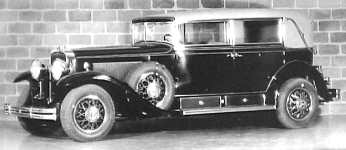
Chassis #336340 or #337668 ...
or neither of these?
This one has hood louvers typical of 1930 Cadillac & LaSalle cars
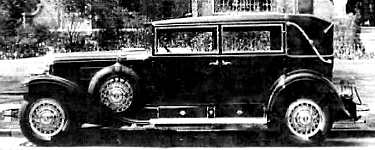 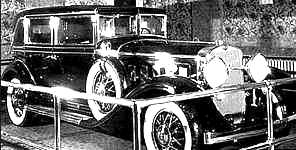
Left: one of two Harley Earl's custom Madame X
models mounted on the 1929 Cadillac (or LaSalle?) V8 chassis
Right: The first V-16, on show in New York, Jan. 1930 (said to be style
#4108C
but the car did not feature the light-colored roof covering typical of that
Fleetwood style)
Some sources - including Earl himself, who
asserted as much in an interview he gave in 1954 - contend that the first Madame X
was built on a La Salle chassis; however, the wheel covers on the car
(unfortunately not visible in the above, compressed digital image) carry the Cadillac
crest, not the La Salle logo. In my opinion, therefore, the car was indeed a
Cadillac and not a La Salle.
A rare car such as this model would be unlikely to just "disappear".
As stated above, I have a feeling that the body may have been subsequently removed
from the V8 chassis and put on the first V-16 chassis readied for the New York show in
January, 1930, with the new V-16 hood featuring five louver doors.
Many Cadillac experts would like to include in the
Madame X category only the type with the flat, raked windshield, built in
Detroit. In my opinion, however, because the first (or prototype) Madame X
car [photo above, left] had the almost vertical "V" windshield and the rare,
split instrument panel, all the Pennsylvania-built sixteens with the same windshield and
dash panel must have an equal claim to the Madame X designation.
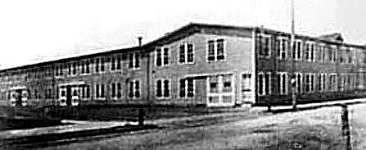 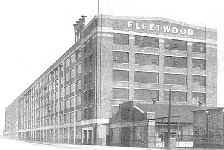
Left: The old Fleetwood plant in the town of
Fleetwood, PA
Right: the modern plant in 1936
Sixteen-cylinder
Cadillacs with the Madame X designation in the Master Parts List are the rarest
and most expensive of the first generation sixteens of 1930-31. They cost $1000 more,
each, than the counterpart Fleetwood styles with Job/Style numbers beginning
"43...".
1. Madame X
cars with a vertical,"V"-windshield
The earliest Madame
X sixteens were built in Fleetwood, PA, from December 1929 up to the spring months of
1930. These feature an almost vertical, split-"V" windshield and an
equally "split" instrument board grouping a number of the instruments in front
of the driver and the remainder in front of the passenger (the owner/operator's manual
does not specify whether two competent drivers were required to be seated in the
front compartment whenever the care was under way!). My guess is that a score or more of these
"V"-windshield types were built before Fleetwood ceased building cars at the old
Pennsylvania plant. My
guess is that the "V" windshield types all have engine/chassis numbers in the
range from #700001 to about #701700 [I have a photo of a "V"-windshield style
#4175 with engine/chassis #7001659; it was built in May, 1930].
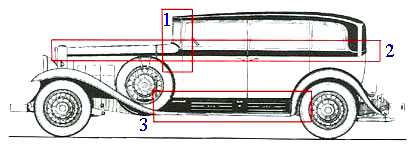 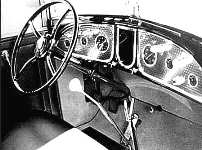
Left: common styling characteristics of Madame
X cars built in Fleetwood, PA, are an almost vertical,
split "V" windshield (1). a the horizontal belt molding (2), and a
horizontal sill (3); these cars have also the rare,
split instrument panel [photo, right] in which part of the instruments are placed
in front of the driver
while the remainder face the front passenger seat
2. Flat, raked
windshield
(b) the later, more
common version, built in Detroit, MI, starting in April 1930, featuring a flat windshield
raked back at an angle of 18º from vertical and an engine-turned instrument panel on
which the instruments are grouped in an oval display in the center. This is the
panel found on all other sixteens of 1930-31, with the exception of one known custom
job built by the Dutch/British coach-builders Van den Plas (the latter car is described in
this section.
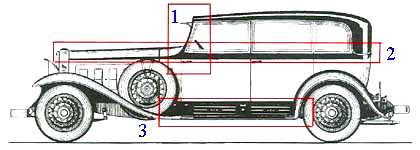 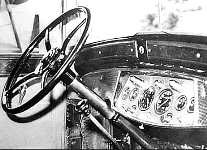
Left: common styling characteristics of Madame
X cars built in Detroit, MI, are a flat, slanted windshield (1).
again a the horizontal belt molding (2), and again a horizontal sill (3); these
cars have the more common
V-16 dash panel [photo, right] in which the instruments and gauges all are grouped
in the center
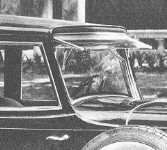 
Here again are the two principal styling features of
the Detroit-built
Madame X models: the flat, slanted windshield (left)
and the horizontal body sill (right)
Although Fleetwood organized and kept a thorough
record of production of all sixteen cylinder Cadillac models by job number [Pennsylvania
cars] or style number [Michigan cars], nonetheless, they appear to have failed to
distinguish between the Fleetwood-built and the Detroit-built Madame X cars,
although, as you can see, there is a striking difference between them.
The oldest piece of advertising material I have seen on the Sixteens
is an album of photos of artist's renderings of Fleetwood proposals for the new V-16
chassis; I saw it in the Thomas McKean collection of the Free Library of Philadelphia,
in 1982. The latter contained 40 artist's renderings including [in that order] styles
#4130-S with "V" windshield, #4130 with "V" windshield, #4130-S with
slanting windshield, #4130 with slanting windshield, #4155-S with "V"
windshield, #4155-SC with "V" windshield, #4161-S with slanting windshield,
#4175-S with "V" windshield, #4161-S with slanting windshield [second view],
#4175 with "V" windshield, #4175-S with slanting windshield, #4175 with slanting
windshield, #4207, #4208, #4212-C, #4220-B, #4225-C, #4235 with top down,
#4235 with top up, #4264, #4264-B, #4280 with top down, #4280 with top up, #4291, #4302,
#4312, #4320, #4325, #4330, #4330-S, #4335, #4355-S, #4355, #4355-C, #4361-S, #4375-S,
#4375, #4376, #4380, #4391.
That large Photo Album, with a
leatherette cover and embossed Cadillac crest
contains only photos of artist's
views of the various Fleetwood proposals; there are no designer's drawings nor photos of
any completed cars. Proposed styles are listed in three columns, in the order shown
below:
[1st column]
#4161-S, #4130, # 4130-S, #4155, #4155-S, #4175 and #4175-S (i.e. the Madame X
cars);
[2nd column]
#4235, #4276, #4212, #4220, #4225, #4291, #4264 and #4264-B (although these became the coach
sill styles, many of the original artist's drawings still show the cars with
straight, horizontal sills);
[3rd column]
#4302, #4380, #4335 (i.e. the convertible styles), #4376, #4381 (i.e. the coupe styles),
#4361-S, #4330, #4330-S, #4355, #4355-S, #4375, #4375-S (i.e. the sedan and limousine
styles), #4312, #4320, #4325 and #4391 (i.e. the town cars and town broughams).
In addition to the photos of the artist's
renderings are some detailed descriptions of the more popular body features, both inside
and out. They appear in the following order: V-16 engine, description of style #4302,
picture thereof, description of style #4260, picture thereof, description of style
#4380, picture thereof [3 views], description of style #4276, picture thereof [with coach
sill but wrong belt molding], description of style #4235, pictures thereof [with top up
and top down; incorrect belt molding], description of style #4335, picture thereof,
description of style #4376, picture thereof, description of style #4381, picture [this
model only became available in the fall of 1930], description of style #4330-S, picture
thereof, description of style #4130, picture thereof [with slanting windshield],
description of style #4355-S, picture thereof [this model has 2 concealed package
compartments in the rear quarters], description of style #4375-S, picture thereof,
description of style #4175, picture thereof [with slanting windshield], description of
style #4312, picture thereof, description of style #4212, picture thereof, description of
style #4220, picture thereof, description of style #4320, picture thereof, description of
style #4225, picture thereof, description of style #4325, picture thereof,
description of style #4291, picture thereof, description of style #4391, picture
thereof, description of style #4264-B, picture thereof [with case work -
specifications say that special hand painted cane work is applied on the lower
rear doors and quarter panels].
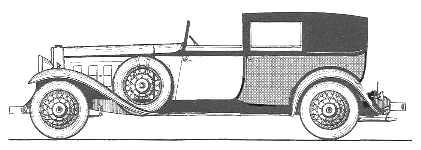 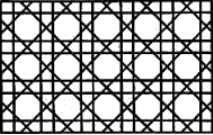
The style drawing [left] was prepared by the author
by adding
French cane work to the official designer's drawing for style #4264-B
[ RH image: full size design, from France's l'Auto Carrosserie, circa 1929
]
With the exception of Fleetwood style #4175,
I have found no indication anywhere of the precise number of the following
Pennsylvania-built jobs with the almost vertical, "V" windshield and split
instrument panel: #4130, #4130-S, #4155 and #4155-S. Therefore, I have based
my estimate of production numbers on the known ratio for style #4175, that is roughly 1:5,
the lower figure being the one for the Pennsylvania-built cars. In addition, as
stated above, I believe that all the "V" windshield cars probably have a
chassis/engine number lower than #701700.
Listed below, in ascending order of
rarity, are drawings that illustrate the different body types built by Fleetwood on the
new V-16 chassis for 1930-31. The majority of these line drawings are from the
envelope of drawings that came with the superb catalog, below, illustrating the new
models. That envelope contained around thirty such drawings on tracing paper (the number
and selection of these drawings varies from one catalog to another). The latter has become
such a rare item today that it is difficult to draw up a precise list of all the drawings
that were thus available. Thanks to vee-sixteen aficionado, Craig Watrous, who
shared with me his knowledge of early V-16 styling. In this section of the Cadillac Database©, I believe you will ALL the official
drawings, plus a few more that I put together from bits of other drawings
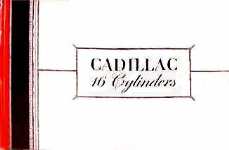 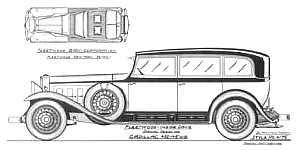
(Left) Cover of the prestige catalog of 1930 V-16
models; at right : sample line drawing
[enlarged, compared to catalog cover], drawn from the envelope of designer
drawings
[ these ranged in number from the upper twenties to the mid-thirties; I'm guessing
that new designs were added as production progressed, e.g. 1931 style #4381 ]
The drawings below are slightly modified,
with a view to standardizing this presentation and for greater image clarity, I took the
liberty of deleting the interior plan drawings, the captions and the original window
"shading". In addition, where a particular drawing was missing or did not
appear to have been provided by the factory, I tried to create my own interpretation of a
given body style by making a montage from parts of other drawings, integrating such
modifications as needed.
Below this table are some artist's
renderings of many of the body styles in this section, as well as factory photos. If
you click here you will be able to access a separate page with
descriptions and photos of surviving sixteens of 1930-31.
Some "expert" sources [e.g.
Old Cars Price Guide, self-styled Definitive Publication for
Enthusiasts, Collectors and Dealers] continue to include convertibles, phaetons, town
cars and 2-door coupes among the Madame X models. These most definitely are
not in the Madame X category. There are no
open-bodied Madame X styles [except for the partly convertible
landaulet styles], nor are there any 2-door cars in this group.
Of note is the fact that a few unique, custom V-16 coupes effectively are described in the
Cadillac Master Parts List (MPL) as having a Madame X-type (slanting) windshield
- even though some Madame X cars were built in Pennsylvania and have a vertical
"V" windshield . The latter do not enjoy full Madame
X status.
All 1930-31 Madame X styles, without exception, have a styling code that begins
with initial digits "41...". In addition, all of them, again without exception, are 4-door sedans and limousines
for 5 and 7 passengers. Some of them have a collapsible roof portion over the rear
quarters; the latter, landaulet styles were among the first Madame X
sixteens to be built.
A rare few, full-fledged Madame X models
were built also in 1932 and 1933; all of them were built in Detroit. They are listed
at the foot of this table.
The models
listed below
are the only, true Madame X cars
Style 4175 (Detroit
style) [86 units]: 5-passenger limousine. Cost
$7525. Article in SIA106, p.34. There are a few survivors.

Easy ID: plain metal roof, large quarter
windows, flat,
18º slanting windshield, instruments grouped in center of
oval panel,
division glass, full-width, folding auxiliary seating
Style
4175-S [47 units]: All these 7-passenger sedans
were built in Detroit. Cost $7225. Again, there may be a number of survivors.

Easy ID: identical in outward appearance to
Fleetwood
style 4175 (Detroit style), above, but with no
division glass nor any auxiliary seating
Style
4161-S [43 units]: All these close-coupled
5-passenger sedans were built in Detroit. Cost $6950. Article in CC&CC 6/1981, cover
and pp.36-42, details include "unidentified" V-16 logo, Heron hood
ornament, flat windshield, chrome hood ventilators, rear interior door panel, rear seat,
rear quarter panel storage compartment, instrument, panel, engine, engraved rear view
mirror back, wire wheel, running boards, door handles. At least one known survivor (the one in the foregoing article).
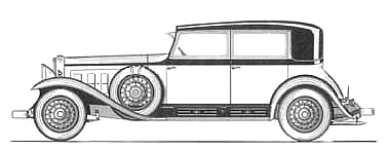
Easy ID: plain metal roof, semi-blank
rear quarters (no
quarter windows), flat, 18º slanting windshield, centered
oval instrument panel, no division glass, no auxiliary seating
Style 4130-S (Detroit
style) [circa 37-39 units]:
5-passenger sedan. Cost $7300. Article in SIA106, p.34. At least
one survivor.
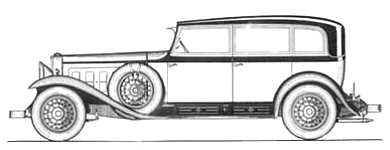
Easy ID: plain metal roof, small quarter
windows, flat,
18º slanting windshield, centered oval instrument
panel, no division glass, no auxiliary seating
Style 4175 (Fleetwood
PA style) [24 units]: 7-passenger limousine.
Cost $7525. One known survivor.
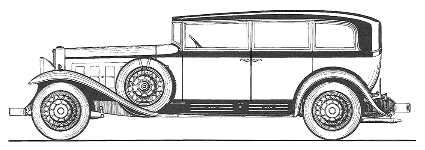
Easy ID: plain metal roof, large quarter windows,
vertical "V" windshield, split instrument panel,
division glass, full-width, folding auxiliary seating
Style 4130 (Detroit
style) [circa 10-12 units]: 5-passenger limousine
(with division). Cost $7300. Article in SIA106, p.34. Some survivors, including one in France that belonged to the late Serge
Pozzoli. I took photos of the car at the Musée du Gérier, near Paris].

Easy ID: similar in appearance to Fleetwood
style 4130 (Detroit-style), above, but with
division glass and auxiliary seating
Style 4130-S (Fleetwood
PA style) [circa 10-12 units]: 5-passenger sedan.
Cost $7300. One possible survivor [have a photo].
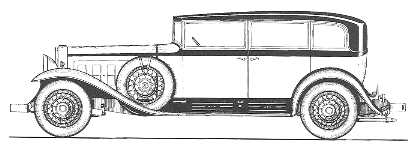
Easy ID: similar in appearance to Fleetwood
style 4130 (Pennsylvania style), below, but
without division glass and auxiliary seating
Style 4155 (Detroit
style) [circa 7-8 units]: 5-passenger formal
limousine (with division). Cost $7350. Article in SIA106, p.34. No known
survivors.
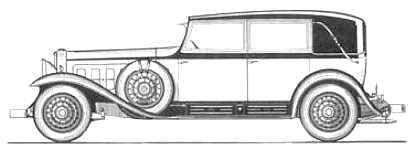
Easy ID: leather-covered metal roof, blank
rear quarters (no
quarter windows), flat, 18º slanting windshield, centered oval
instrument panel, division glass, light-weight auxiliary seating
Style 4130 (Fleetwood
PA style) [circa 5-7 units]: 5-passenger limousine
(with division). Cost $7300. One possible survivor
[have a photo].

Easy ID: plain metal roof, small quarter
windows,
vertical "V" windshield, split instrument panel,
division glass, light-weight auxiliary seating
Style 4155-S (Detroit
style) [circa 5-6 units]: 5-passenger formal
sedan. Cost $7125. Article in SIA106, p.34.

Easy ID: leather-covered metal roof,
flat, 18º
slanting windshield, centered oval instrument
panel, no division glass no auxiliary seating
Style 4155-C
[5 units]: Detroit-built 5-passenger formal limousine-landaulet. Cost
$7350. Article in SIA106, p.34. One survivor located in
Zürich, Switzerland. Was once converted to a fire-truck then, later, back to its (almost)
original state. Many photos.
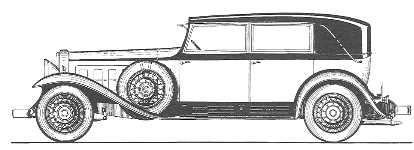
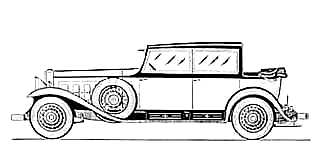
Easy ID: similar in appearance to Fleetwood
style 4155S (Detroit style), above, but with
division glass, auxiliary seating and
folding quarters over the rear seat.
Style 4108-C
[4 units]: this is a Pennsylvania-built, 5-passenger formal landaulet-limousine
without quarter windows; it is also similar in appearance to style 4155C, above. It
too has a folding roof portion over the rear quarters. In fact the New York show car
is an almost exact replica of Harley Earl's 1929 custom job [photographed at the top of
this page]; I am inclined to believe that one of these four units was fitted with the body
from Earl's 1929 "prototype" creation. Also, I am assuming that these
four jobs initially were labeled 4155-C, since the body numbers are in the same
series with the "4155" group; they may have been assigned the new style number
(4108-C) after receiving a special, light-colored fabric-grained leather roof covering (coupienne),
a job which I believe was done by Don Lee in California. These tops were copied
from a special Cadillac V8 model by Fleetwood that had been displayed at the Paris salon
in October 1930; it was labeled style 4208 owing to its curved, or "coach"
sill. Of the four Madame X imperial landaulet cars built in Fleetwood, PA,
one of them - presumably body #1 - was the first vee-sixteen to be completed, ready for
show in New York in January 1930; as I said before, I believe it could have had the body
off Earl's 1929 prototype. At the NY show it had still the regular, black leather
roof covering. This style, like all Madame X sixteens with the vertical,
split-"V" windshield features a two-part instrument panel; half of the gauges
and instruments are placed in front of the driver; the other half are located in front of
the front seat passenger. There is a division and partition glass between the front
and rear compartments, as well as two, light-weight, folding auxiliary seats; the left one
faces right, the right one faces the rear. This car cost circa $10000 in 1930 [$9988
to be precise]. Only four were built; only one of them is known to have survived.
The full story of the latter car was published in CC&CC, 8/1986, pp.34-40
and in CLC the same month. The car remained for many years in the collection of Dave
Towell, a Cadillac dealer in Akron, OH. As I recall, he said he had acquired it from
the family of the first owner. I was fortunate to be able to admire it when I
visited Dave in 1978. The car was subsequently acquired by Steven Nanini of Tucson,
AZ; he painstakingly restored it to its initial glory. Among the photos published
with the two mentioned articles are, inter alia, the front ensemble, the robe cord, vanity
case, clock and smoker's case, the engine, landaulet top down, grille badge and door
handles. Interestingly, the latter were mounted upside down during the meticulous
restoration process; fortunately, that mistake was subsequently corrected. :Click here for a more detailed
account about this rare model.
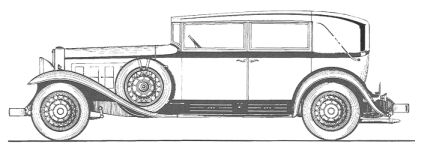
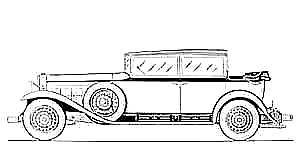
Easy ID: light-colored top, folding over the
rear seat
area, vertical "V" windshield, split instrument
panel, division glass, light-weight auxiliary seating
Style 4155-SC
[2 units]: Detroit-built 5-passenger formal landaulet-sedan. Cost
$7350. Neither is believed to have survived.


Easy ID: similar in appearance to Fleetwood
style 4155C, above, but without
division glass and auxiliary seating
Style 4155 (Fleetwood
PA style) [circa 1-2 units]: 5-passenger limousine
(with division). Cost $7350. No known survivors.
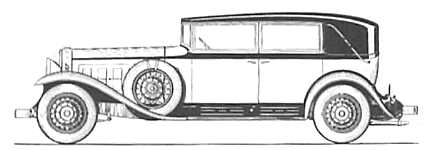
Easy ID: leather-covered metal roof, blank
rear
quarters (no quarter windows), vertical "V"
windshield, split instrument panel, division
glass, light-weight auxiliary seating
Style 4155-S (Fleetwood
PA style) [circa 1-2 units]: 5-passenger formal
sedan. Cost $7125. No known survivors.

Easy ID: similar in appearance to Fleetwood
style 4155 (Fleetwood PA style), above, but without
division glass and auxiliary seating
Style 4161
[unique]: Detroit-built, close-coupled
5-passenger limousine. Cost estimated around $7500. This car is not known to have
survived.

Easy ID: identical in outward appearance to
Fleetwood style #4161-S,
above, but no division glass inside
A rare few, authentic Madame X models
were built in 1932 and 1933; all of them were built in Detroit. They include:
Fleetwood style #5131 (5 units built in 1932)
Fleetwood style #5131-S (2 units built in 1932)
Fleetwood style #5155 (4 units built in 1932)
Fleetwood style #5155-C (1 unit built in 1932)
Fleetwood style #5165 (1 unit built in 1932)
Fleetwood style # 5531 (3 units built in 1933)
Fleetwood style #5531-S (1 units built in 1933)
Fleetwood style #5555 (2 units built in 1933)
Fleetwood style #5555-C (1 unit built in 1933)
Fleetwood style #5565 (4 unit built in 1933)
The styling features of the preceding cars will be
addressed in the appropriate sections of the Database for 1932 and 1933
____________________________________
1
Not Madam X (without an "e") as held by some [CLC, 7/91, p.10] even
though that spelling does appear thus, in error according to the late Phil Dumka, in
Cadillac's own Master Parts List dated January 2, 1934)
2 The product catalog for the early sixteen-cylinder cars
includes an envelope with designer's drawings of the most common styles offered; the
number and selection of these drawings appears to vary from one catalog to another and not
all styles are represented so it is difficult to determine precisely the number and models
thus illustrated; where there was no drawing, I have taken another one and modified it so
as to try to represent the missing style; in some cases where neither designer's drawing,
artist's rendering or factory photo exists, I have simply used my imagination; the latter
drawings, therefore, should not be considered "factory authentic".
|
![]()
Photo Chatterton